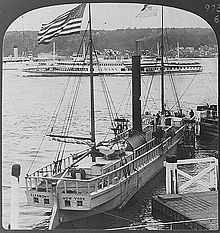North River Steamboat
|
||||||||||||||||||
|
||||||||||||||||||
|
||||||||||||||||||
|
||||||||||||||||||
|
||||||||||||||||||
|
||||||||||||||||||
The North River Steamboat , also known as the Clermont , was the world's first commercially successful steamship . The side wheel steamer was designed by the American Robert Fulton and commissioned as a liner in 1807 .
history
Historical context
The North River Steamboat was not, as the literature often claims, the first working steamboat in the world, but the first to be used with commercial success. The first ever steam- powered ship was invented by the French Huguenot Denis Papin in Kassel in 1707 , after he had already invented the principle of the atmospheric steam engine in Marburg an der Lahn in 1690 . Then in 1776 the Frenchman Claude de Jouffroy d'Abbans built a side wheel steamer with the Palmipède . Overall, the North River Steamboat was the 13th operational steamship in history. At the same time, after the Charlotte Dundas built by the Englishman William Symington from 1802, it was the second ship suitable for practical use with this drive.
Clermont
The development of the North River Steamboat , just called Clermont by later generations , was a joint project of the politician and investor Robert R. Livingston and the engineer Robert Fulton. She was used from 1807 as a ship of the line along the Hudson River between New York and Albany (distance 240 km or 150 miles ). The maiden voyage took place on August 17, 1807. The steamship required two days for this voyage, which significantly shortened the previous one-week voyage. Robert Fulton's ship also proved to be economically successful and paved the way for further steamship traffic. In 1809 with the Raritan and in 1811 with the Car of Neptune, two more steamships were put into service.
The North River Steamboat was in service as a passenger ship for many years before it was retired and replaced by newer, faster ships that were also paddle steamers .
The ship
The wooden ship originally had a length of 40.54 m, the hull was flattened at the bottom and had a width of 3.96 m on the ship's bottom and 4.88 m on the deck . In the winter of 1807/08 the ship was rebuilt, the hull was lengthened to 45.42 m and to stabilize the ship, it was widened to 4.88 m on the ground and 5.46 m on the deck. During this conversion, the ship also received a new copper steam boiler .
The Clermont had a single-cylinder steam engine of the Boulton & Watt design , but was still equipped with sails and reached a speed of 4.5 knots (8.3 km / h ). The steam was generated in a 6.10 m long, 2.44 m wide and 2.13 m deep box-shaped steam boiler. The cylinder of the steam engine had a diameter of 0.61 m and a piston stroke of 1.22 m. This was used to drive two paddle wheels with a diameter of 4.57 m that were not enclosed.
On February 11, 1809, Robert Fulton received a patent on his propulsion system, which was essentially based on an extensively modified design by Isaac Briggs and William Longstreet , who had received a patent on February 1, 1788 (the first patent on a steamship ever) .
designation
The name North River Steamboat was derived from North River, the old name of the Hudson River. The name Clermont for the ship comes from Livingston's estate, which the steamer often called. After the conversion, the ship was put back into service on May 1, 1808 under the name North River Steamboat of Clermont and later only the name North River was used. In an 1817 biography by Fulton, the ship was mistakenly named Clermont . This name is used to this day.
Replica
In 1909, a replica of the aborted ship was created in Staten Island , New York , as an exhibit to mark the 300th anniversary of the discovery of the Hudson . This Clermont (1909) was canceled in 1936.
See also
Web links
literature
- Alice Crary Sutcliffe: Robert Fulton and the "Clermont" , New York 1909, ( online )
- Thomas W. Knox: The life of Robert Fulton and a history of steam navigation , 1886, ( online )
- Ships: sailing ships, warships, passenger and merchant ships , Fränkisch-Crumbach 2016, ISBN 978-3846800225 , p. 166
Individual evidence
- ↑ Jim Wegryn: Famous Ships and Boats
- ^ Robert H. Thurston: Robert Fulton: His Life and Its Results , New York 1891, p. 126 ( online )
- ^ Edward Hagaman Hall: Hudson and Fulton , New York 1909, p. 47 ( online )
- ↑ HW Dickinson, Robert Fulton, engineer and artist , London 1913, pp. 228, 236 ( online )
- ^ Peyton F. Miller: The story of Robert Fulton , New York 1908, pp. 66, 76 ( online )

